How did Stanley Kubrick decide to produce a film version of The Shining? I first presented this post in 2016.
In last week’s post I talked about Stephen King’s 1977 novel, The Shining. I have to believe that it initially thrilled the author to learn the film rights had been acquired by renowned director Stanley Kubrick. But ultimately, he did not like the end result.
 CAN HORROR NOVELS FLY?
CAN HORROR NOVELS FLY?
Stanley Kubrick had already achieved a great deal of critical acclaim by the late 1970s with films such as Spartacus, Dr. Strangelove, 2001: A Space Odyssey, and A Clockwork Orange. Now determined to find commercial success by directing “the scariest horror movie ever,” Kubrick took it upon himself to find the right project.
His secretary at the time recalls that Kubrick had stacks of horror novels all over his office. He would begin reading, and after a few pages he would disgustedly fling each book across the room, where it would bang against the wall. This went on for quite a while, until one day the secretary noticed that it had been quiet for some time. She peeked in and saw him totally engrossed in The Shining.
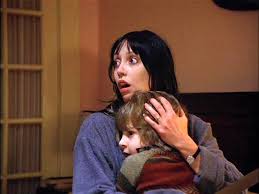
Wendy and Danny are a bit worried about dear old Jack.
Kubrick’s first and only choice to play Jack Torrance, King’s main protagonist, was Jack Nicholson—and that, you could say, was where the problems began. Acclaimed actor Nicholson had already won an Academy Award for playing “leering loony” Randle McMurphy in the 1975 hit, One Flew Over the Cuckoo’s Nest, and his “leering loony” portrayal of Jack Torrance was not what King had in mind. One critic described the difference between the novel and the movie as a sane man driven slowly mad by forces within the haunted hotel, as opposed to—in the film—an already crazy guy who may or may not be struggling to regain his sanity. Nicholson’s “leering loony” persona going in only added to the viewers’ perception.
SIMILARITIES AND DIFFERENCES
I offered an overview of the basic plot in discussing the novel, so no need to do that with the movie, which just about everyone has seen since its release four decades ago. In twenty-five words or less: alcoholic, struggling writer takes job as winter caretaker at old hotel, descends into madness as malignant spirits make him try to kill his family. That does not change.
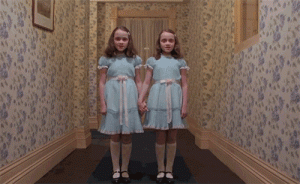
“Come play with us, Danny…”
But in the novel we learn much about Jack’s background, his problems, his sincere desire to right the past wrongs he has inflicted on himself and his family, whom he fiercely loves. In fact, Danny Torrance is closer to his dad in the novel, while he clings to Wendy, his mother, in the film. No wonder, given that Jack’s “leering loony” is evident as early as their drive up the mountain to the Overlook Hotel.
Danny is much more open with certain people about his powerful telepathic abilities in the novel, including a doctor in a nearby town and, of course, his mentor and friend, Dick Hallorann. He is much more reserved in the film, even with Dick. His “imaginary” friend and conscience, Tony, is manifested through a gravelly voice and a wagging of his finger. In the novel, Tony is a physical presence in the form of a teenage boy—possibly Danny’s future self.
“WENDY, I’M HOME!”
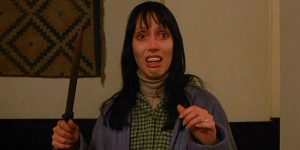
Wendy is ready to go back home.
Shelley Duvall played Jack’s long-suffering wife, Wendy, and to many critics her portrayal seemed like “Olive Oyl in a haunted hotel.” She is meek and mild, seemingly afraid of her husband, who might have smacked her around in the past, and at the least verbally abused her. Hard to say if this was on Duvall or Kubrick. The perfectionist director worked his actors mercilessly, often doing dozens of takes to shoot one scene, and Duvall seemed most affected by his methods. It is believed that he cut many of her lines due to his dissatisfaction with how she delivered them. You have to wonder why he didn’t just replace her.
This is one of the most obvious differences from the novel. King presents a strong, self-reliant woman whose fierce loyalty to her family is likely a result of her alienation from her parents, specifically her mother. Her portrayal in the subsequent mini-series by Rebecca DeMornay, which I’ll discuss next week, is far more spot on.
“HERE’S JOHNNY!”
As mentioned last week, in the novel the malignant spirits of the Overlook are more intent on bringing Danny into the fold, given his supernatural proclivities. In the film Danny is only in the way as they set their sights on Jack—who might have already been at the hotel in a past life or lives.
Doubtless you recall the two creepy little girls who invite Danny to play with them as he rides his Big Wheel through the hallways, and the gallons of blood that spew forth from the old elevator. Neither of these happened in the novel.
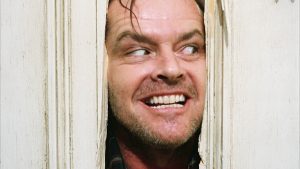
“Here’s Johnny!”
One of Jack Torrance’s goals was to begin writing again during the long winter. In the novel he works on a play, and the helpful hotel even shows him a scrapbook filled with news clippings about the Overlook’s past, both good and bad. This further motivates him to consider writing a book about the place. Not so in the film: another iconic scene comes after he’s been typing away furiously for days. Wendy takes a peek at his thick manuscript, where Jack has written one line over and over, thousands of times: All work and no play makes Jack a dull boy.
In perhaps the most iconic scene of all—also not in the novel—Jack hacks a hole in the door behind which Wendy has taken shelter, pokes his leering head through and says, “Here’s Johnny!” Of course it wasn’t in the book, because Nicholson improvised it, as he did many other lines. Curiously, Kubrick had never seen The Johnny Carson Show and had no idea what it meant. He almost cut the scene.
THE DENOUEMENT
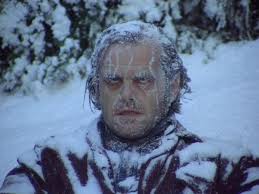
Jack did not enjoy his romp through the hedge maze.
When Dick Hallorann (Scatman Crothers), after a harrowing cross-country journey in response to Danny’s psychic cry for help, arrives at the Overlook, he is promptly killed by Jack. In the book he is injured by the hedge animals (a hedge maze in the film) but survives and is able to help Wendy and Danny get away. The fact that he lives becomes an important element decades later in King’s sequel, Doctor Sleep.
Finally, the fate of the Overlook Hotel differs greatly in the two media. As mentioned last week, the hotel is leveled in an explosion caused by too much pressure built up in an old boiler as Jack dies and Wendy, Danny, and Dick flee on a snowmobile. In Kubrick’s vision, Jack freezes to death in the hedge maze as Wendy and Danny flee in dead Dick’s snow cat. The Overlook remains standing, and a photo on the wall shows Jack as one of the revelers at a party from the Roaring ’20s.
Don’t get me wrong here. I’m not knocking either the film or the novel, just pointing out some of the differences. Truth be told, I love them both, and each one is a classic in its own right. Despite doing fairly well at the box office, Stanley Kubrick’s The Shining initially received rather lukewarm reviews. But over time critics have come to see it in a different light, and these days it is high on everyone’s Top Whatever lists of horror movies and thrillers.
Seventeen years after Kubrick, Stephen King—to paraphrase an old commercial—had it his way in a four-and-a-half hour mini-series of The Shining. I’ll discuss this next week in Part Three, as well as King’s sequel to his novel, Doctor Sleep—plus some thoughts on the film version of the latter.
